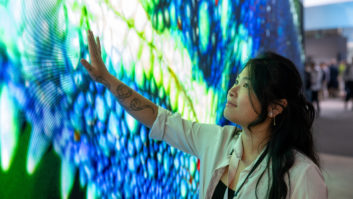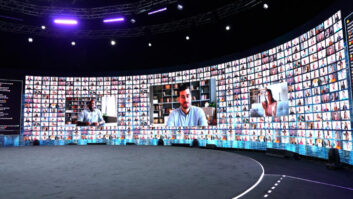Once described as the worst stadium in English football due to its ‘soulless atmosphere’ – the Ricoh Arena is using AV technology to inform, entertain and interact with fans before, during and after the match
Built in 2005, the 32,609 seater Ricoh Arena complex in Coventry, is one of the UK’s leading multipurpose venues for sports and entertainment.
The stadium, housed just off the M6, has been the home venue (a short hiatus in 2013) for local football team Coventry City (replacing Highfield Road) since its completion, and Rugby Union side, Wasps since 2014. The stadium has played host to numerous international sporting fixtures – including the 2012 Olympic football – as well as major music events, including Bryan Adam, Oasis, Bruce Springsteen and – later this year – classic rockers Bon Jovi and the Spice Girls.
However, in recent years the stadium has been subjected to heavy criticism from fans, both local and visiting. In April 2017 the Ricoh Arena was listed by FourFourTwo magazine as the worst stadium in English football, blasted as creating a “depressing experience” in an “often soulless atmosphere” in a “virtually empty” stadium.
Efforts to enhance the experience have however been made, and since October last year, the arena has been home to one of the largest giant LED screens in UK sport. Measuring 188 square metres (the equivalent of 673, 32 inch TVs) and housed in the South Stand, the display has been built to provide, what it claims to be, the best in-game match day experience in the country.
To learn more, AVTE caught up with the commercial director at Wasps and the Ricoh Arena, Stuart Cain to learn more the club’s digital display strategy.
Hi Stuart. Tell us about the new screen installed at the Ricoh Arena.
Our new state-of-the-art screen has been installed by ADI – who work with many sports stadia across the UK. The screen is rectangular in shape and has prime position in the centre of the South Stand, dominating the in-bowl experience with 188 square metres of the highest quality LED panels. Our screen has a striking super-wide format, which enables us to create content in multiple formats.
How did you decide on the size and shape of the screen, as well as the features it offers?
We really wanted to push the boundaries of what an in-stadium screen could do, by going with the super-wide format we are really able to maximise the spectator experience and maximise exposure for our sponsors and partners.
During a rugby game we are able to show the live action feed in the centre portion of the screen, while simultaneously showing advertising, in-game information such as scorers and substitutions/replacements and referee decisions on the right-hand side, and having a permanent scoreboard and clock displayed on the left-hand side.
After just four years in Coventry we have the second highest average attendance in the Gallagher Premiership (17,500), but there is still spare capacity in the stadium so the screen is a great way of helping new fans of rugby understand the game if we link the on-screen activity with other digital initiatives such as the Wasps app.
How does this screen compare to those deployed at other venues?
We understand that our screen is one of the biggest in UK sport, but we believe as a top-flight rugby club we are the first to have such high-quality interactive content running through multiple zones of the same screen simultaneously.
When did work first begin?
The screen infrastructure project has been in the pipeline for a long time, the planning started almost a year ago, the installation process started back in June and the first game to feature the new screen was Wasps vs Gloucester in October.
Why have you chosen just one end? Will this be a disadvantage to some supporters?
To deliver the objectives of integrating match footage, social media, rugby decisions and sponsor messages we had to use the larger screen and this was the only location that made sense. It gives people in three of the stands a brilliant view of the content and those in the South Stand can see the screen if they turn around. Our ultimate ambition is to replicate with a second screen in the North Stand but that’s a year or two away.
What was your primary motivation for introducing the big screen?
The primary motivation was definitely around fan experience, we are trying to build the best match day experience in the country for our supporters, which forms part of Wasps Group’s overarching strategy to make the Ricoh Arena one of the most digitally-connected venues in the events industry.
Our previous screen served a purpose but it didn’t really have the capacity to heighten the enjoyment of the game for supporters in the stand. In addition the new screen also enables us to bring our partners closer to the people in the ground, activating exciting promotions and initiatives.
It also increases the involvement of our supporters on a match day, as they can send in good luck messages via video on social media which are played out on the screen ahead of kick off.
The big screen is another part of our digital jigsaw and complements the high-density free Wi-Fi which was recently installed at the venue, allowing up to 20,000 people to log on and stream content at the same time.
Tell us about what else the screen will be used?
In addition to partner advertising, we also show video and graphics explaining the rules of rugby, showing referee decisions, try scorers and replacements. We are also utilising a roaming camera in the ground where we can put the supporters on the big screen, do pre-game and half time interviews on the pitch and we’ve even done a ‘floss cam’ showing the best dancers in the ground.
This is just the start and we are constantly thinking of new ways we can use the big screen to enhance the match day experience.
From an interactive point of view, how do you overcome the typical issues around network coverage in a sporting stadium?
Working with our partners, Ericsson and CityFibre our Wi-Fi infrastructure is one of the best in the country and we can withstand having more than 20,000 users at any one time, so we don’t experience many issues around connectivity. An ADI representative is also on hand for every event at the Ricoh Arena that is using the screen, so that if any issues do arise they can be sorted swiftly.
Of course, the screen is nothing without content.
The screen output on a match day is controlled by ADI in Preston, from a production suite in their head office, but they are on radio comms with club representatives at the ground who direct what is meant to appear when. This has been working really well and we are the first Premiership Rugby club to do things this way.
In terms of creating content, we have a number of different sources, we have our own video production team in-house, we work with external design and production agencies and ADI also produce a lot of the content for us.
Is all content controlled/managed at the stadium?
We have a floor manager employed by us that is pitchside and watching the game unfold. He is linked to a production suite controlled by ADI in Preston. This means we have people with rugby knowledge watching the game and working “as live” with an equally knowledgeable production crew in Preston. The content itself is developed at the Ricoh Arena.
How (if at all) does content vary between sporting events?
Coventry City Football Club also use the screen for their matches, but control and manage the screen content themselves on their match days, and don’t use the services of ADI in Preston in the way that Wasps do. As such, the football club’s content mainly consists of a scoreboard and then pre-loaded videos for pre-match and half-time entertainment.
What about audio?
We have retained the existing infrastructure of speakers within the ground and the new screen has been connected up to these and seems to be working very well.
From an RoI view, how is the display helping financially?
The screen creates an extra platform for the club to be able to generate additional revenue, which in the long-term, will see Wasps Group see a return on the six-figure investment.
There is a clear project plan for the screen, this is a long term campaign that will stand the ground in good stead for the future technological changes. Having the new screen has vastly improved the opportunities for activating partner content and we are already seeing a huge rise in enquiries from companies wanting to be featured on the big screen.
Because we have the screen broken up into three sections during a match day, this means we can have a continuous stream of partner content showing on the right hand side, while the live action happens in the centre portion of the screen.
Beyond the big screen, how prominent are displays in and around the Ricoh Arena?
Our digital strategy and new screen infrastructure is a very important part of the all-round experience at Ricoh Arena. We have not only invested in the new in-bowl screen, but additional LED banners on the front edge of the balcony on the West Stand, a giant LED banner above the main entrance to the venue and hotel, a large video wall just inside the main entrance and more than eight large LED poster sites throughout the atrium area.
In addition to this, we have ten new LED wayfinding podium screens for displaying information about meetings and events in specific rooms in the venue, and over 100 smart-connected TVs around the concourse area.
The Ricoh Arena hosts hundreds of conferences, exhibitions and meetings every year, and having various digital screens gives event organisers the convenient option of putting their visual stamp on the venue for their visitors. It’s a key part of our proposition that event organisers can own the venue from a branding perspective for the duration of their event.
In conclusion, how important is good quality AV in providing an enhanced experience for fans?
We want to be leaders in digital infrastructure and AV is a prominent part of our future marketing strategy for the venue. We continue to invest heavily in content and hardware solutions to heighten visitors’ and clients’ experiences.
Making the bricks and mortar live is crucial for any event space moving forward. Adaptable content, flexibility and the opportunity for digital interaction between the content owner and the audience through the venue infrastructure is only going to become increasingly important as the boundaries between how people engage with their phone and the world around them converge.







